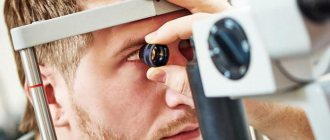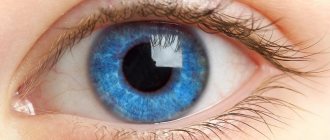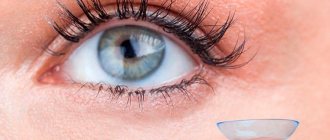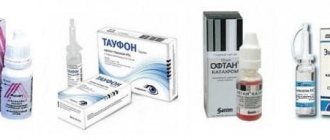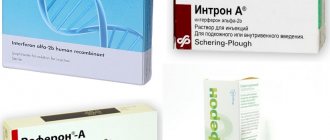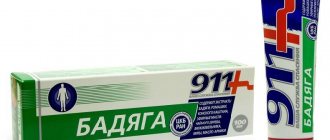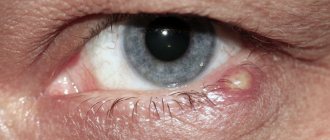The active component of Okomistin is miramistin, a substance with antimicrobial properties.
Drops are used for pathological eye conditions provoked by various pathogens:
- fungal microflora;
- viral pathogens;
- chlamydia;
- herpes infection;
- adenoviruses.
Miramistin in Okomistin is about 0.01%, the auxiliary components are purified water and sodium chloride. Medication is prescribed for pathological eye lesions:
- acute or chronic forms of conjunctivitis;
- blepharoconjunctivitis;
- prevention of purulent-inflammatory complications;
- keratitis;
- keratouveitis;
- eye injuries.
The cost of the medicine is approximately 155 rubles.
More information about the drug can be found here
Pharmacological authorities
Pharmacodynamics.
Benzyldimethyl[3-(myristoylamino)propyl]ammonium chloride monohydrate is a cationic surface-active substance with antimicrobial (antiseptic) action.
The basis of the action of Okomistin® is the direct hydrophobic interaction of the molecule with the lipids of the membranes of microorganisms, which leads to their fragmentation and destruction. When a part of the molecule of the active molecule, embedded in the hydrophobic part of the membrane, collapses the epimembrane ball, fluffs up the membrane, increases its penetration for high-molecular molecule, changes the enzymatic activity of the microbial cell Itinhibits enzyme systems, which inhibits the life of microorganisms and their cytolysis.
In contrast to other antiseptics, Okomistin® has a high selectivity of aqueous microorganisms, and the fragments practically do not affect human cell membranes. This is the effect of binding to the different structure of human cell membranes (a significant increase in lipid radicals, which sharply reduces the possibility of hydrophobic interaction between the cell and cell membranes).
Okomistin® has a pronounced antimicrobial activity against clearly gram-positive and gram-negative, aerobic and anaerobic, spore-forming and asporogenous bacteria in the form of monocultures and microbial associations, including hospital specimens with polyresistant to antibiotics.
It is harmful to everyday illnesses that are transmitted by state methods - gonococci, treponemas, trichomonas, chlamydia, as well as herpes viruses, human immunodeficiency.
Carry out antifungal action on ascomycetes of the genus Aspergillus
and the genus
Penicillium
, yeasts (
Rhodotorula rubra, Torulopsis gabrata
) and yeast-like (
Candida albicans, Candida krusei
) fungi, dermatophytes (
Trichophyton rubrum, Trichophyton mentagrophytes, Trichop phyton verrucosum, T. schoenleinii, T. violaceum, Epidermophyton Kaufman-Wolf, E. floccosum, Microsporum gypseum, Microsporum canis
), as well as other pathogenic fungi (for example,
Pityrosporum orbiculare (Malassezia furfur
) in the form of monocultures and microbial associations, including fungal microflora with resistance Stay before chemotherapy drugs. Under the influence of Okomistin® the resistance of microorganisms to antibiotics decreases. specific protection due to the modulation of the cellular and local humoral immune pathways, which accelerates the disease.
Pharmacokinetics.
Okomistin® exhibits local action. Data about the possibility of penetration of the drug into the systemic bloodstream on a daily basis.
Operating principle
The main component of the drug is active against a large number of infectious agents, including not only harmful bacteria, but also protozoa, fungi and various viruses. Due to this spectrum of action, Okomistin is classified as an antiseptic. The solution also has an anti-inflammatory effect, strengthens local immunity and activates tissue regeneration. At the same time, it does not penetrate into the bloodstream, so the therapeutic effect of Okomistin is exclusively local.
Showing
In complex treatment of infectious processes of the anterior eye (blepharitis, conjunctivitis, keratitis, keratouveitis) caused by gram-positive and gram-negative bacteria, chlamydia, fungi and viruses sensitive to Okomistin y®, eye injuries, eye injuries (thermal and chemical).
Prevention of neonatal ophthalmia, including gonococcal and chlamydial.
Prevention and treatment of purulent-inflammatory eyes in the pre- and post-operative period.
For complex treatment of acute and chronic otitis externa, chronic purulent mesotympanitis, otomycoses.
In complex treatment of acute rhinitis.
Indications
The most common reason for using Okomistin is inflammatory diseases of the organ of vision. This solution is prescribed for conjunctivitis and keratitis, as well as keratouveitis and blepharitis. In addition to the inflammatory process in the tissues of the eye, Okomistin is in demand in the following situations:
- if the child has undergone eye surgery or is preparing for it (the solution will reduce the risk of complications);
- if the baby has injured his eyes;
- if a child has developed a chemical or thermal burn to the eyes.
Okomistin is also used by ENT doctors, prescribing such drops to patients with sinusitis, rhinitis, bacterial otitis and otomycosis.
Method of congestion and dosage
Ophthalmology
For the treatment of infectious processes in the anterior eye
for adults and children under 12 years of age, instill 2-3 drops in the conjunctival sac, for children under 12 years of age – 1-2 drops 4-6 times per serving. The triviality of the treatment does not outweigh 2 years.
By preventing complications in the pre- and post-operative periods
– 2-3 drops 3 times per day 2-3 days before surgery. After the operation - for 3-5 days, 1-2 drops 3 times per day.
When cleaning the eyes
, after rinsing the eye with a large amount of water, carry out partial instillation (5-10 skin sections) for 1-2 years. For further treatment, administer the drug to adults and children up to 12 years old, 2-3 drops each, for children up to 12 years old – 1-2 drops, 4-6 times per dose.
For the prevention of ophthalmia in newborns
Immediately after birth, instill 1 drop of the drug into the skin 3 times at an interval of 2-3 weeks.
Otolaryngology
For treatment of acute and chronic external otitis, otomycosis
For adults and children over 12 years of age, instill 3-5 drops 4-6 times per dose; for children up to 12 years of age - 2-3 drops 4-6 times per serving.
In the external auditory canal, gauze turunda soaked in the drug can be injected 4-6 times per day over a period of 10-14 days (instead of instillation).
For chronic mesotympanitis
To use a comprehensive treatment with the help of ultrasonic equipment or to administer antibiotics to the drum at the same time.
For treatment of acute rhinitis, infection of the nasal mucosa
instill 2-3 drops in adults and children under 12 years of age, 1-2 drops in children up to 12 years of age, 4-6 times per day. Likuvannya course – 7-14 days.
Particularities of dosing.
The exact dosage can be reached by pressing on the bottom of the bottle - one pressing = 1 drop.
Children.
The drug can be used in pediatric practice.
A universal protector for your child.
as an advertisement
Often, illnesses suffered in childhood have consequences that affect health for many years of life. These include diseases of the eyes, ear, nose and throat, which often affect children. Therefore, their timely diagnosis and treatment is very important for the child’s health. In the future, this will help to avoid a number of chronic diseases and serious complications, the initial source of which may be diseases of the eyes, ears, throat, and nose suffered in childhood.
Inflammatory eye diseases in children
Mothers often ask the question: What to do when a child’s eyes become sour? How dangerous is this?
In newborns, dacryocystitis is very common - this is an inflammation of the lacrimal sac, in which there is mucous or mucopurulent discharge from the eye, swelling in the inner corner of the eye. The reason for this is the use of ointment-based antibacterial drugs in the maternity hospital. Similar symptoms are observed with conjunctivitis, but in addition, redness of the vessels of the conjunctiva and skin of the eyelids is also noted. The cause of the disease can also be dirty hands with which children rub their eyes, especially if the child attends a kindergarten where there are sick children (contact conjunctivitis). The causative agent of the disease is usually a mixed viral-bacterial or viral-bacterial-fungal infection. The attachment of a fungus is especially dangerous, since the process can penetrate the orbit and spread to the brain and its membranes.
And here the question : “How can a mother quickly and correctly begin treatment in order to provide first aid and not harm her eyes?”
Answer : Do not use antibiotics, as they have no effect on viruses and fungi at all, so they not only do not improve the condition of the diseased eye, but can also aggravate the inflammatory process. Especially if they are used in combination with hormonal drugs.
The only drug effective against all possible microorganisms that cause infectious and inflammatory diseases of the eyes is Okomistin® , eye/ear/nasal drops, 0.01% miramistin .
Okomistin® is an innovative drug based on the modern highly effective antiseptic miramistin, which does not cause allergic reactions or irritation, since it is an isotonic solution similar in composition to tears, which makes the drops painless and comfortable to use.
Timely use of Okomistin® allows you to avoid the painful procedure of deep probing of the nasolacrimal duct (puncture), which is performed in a hospital setting.
Runny nose in children
The most common cause of a runny nose is acute respiratory viral infections (ARVI). They make up about 90% of all infectious pathologies, are severe, especially in children of the first three years of life, often cause complications and therefore remain one of the most pressing problems in pediatrics.
What to do when children in kindergarten or school start getting sick one after another, how to protect your child? What to do if the child gets a cold and the mother is pregnant? The effect of the virus on the fetus can cause miscarriage or developmental disabilities.
The cause of a runny nose in a general respiratory disease can be not only respiratory viruses. Most often, associations of pathogens arise - viral-bacterial, viral-mycoplasma, or several viruses. In addition to these microorganisms, the human body contains opportunistic microflora, which, as a rule, include pathogens of fungal diseases. They can be activated under conditions of the inflammatory process. When an association of viruses, pathogenic bacteria, fungi and other microorganisms occurs, they have a significant impact on each other and acquire aggressive properties, which is also facilitated by the inhibition of the body’s defenses.
How to properly treat ARVI? The high variability of viruses and the impossibility of creating a vaccine against several hundred ARVI pathogens does not provide complete protection against the disease, even with the help of vaccination. Here Okomistin® , which effectively acts both against viruses that cause colds, and against all other microorganisms that could cause the disease.
Okomistin
Okomistin is an antiseptic used in ophthalmology.
Release form and composition
Dosage form – eye drops, ear drops, nasal drops 0.01%: clear, colorless liquid (1 and 1.5 ml each in polymer tube-droppers for single use, 5 or 10 tubes in a cardboard pack; 5 and 10 ml each in polymer bottles sealed with a dropper stopper and a screw cap with first opening control, in a cardboard pack of 1 or 5 bottles; 10 ml each in polymer bottles, sealed with a dropper cap, in a cardboard pack of 1 or 5 bottles; 20 ml each in glass bottles, sealed dropper cap or rubber stopper and aluminum cap, 1 or 5 bottles in a cardboard pack. Each pack also contains instructions for using Okomistin).
Composition of 1 ml drops:
- active substance: benzyldimethyl [3-(myristoylamino)propyl]ammonium chloride monohydrate – 0.1 mg in terms of anhydrous substance;
- additional components: sodium chloride, purified water.
Pharmacological properties
Pharmacodynamics
The main active ingredient of Okomistin drops is the antiseptic benzyldimethyl-myristoylamino-propylammonium, which has pronounced antimicrobial activity against gram-positive and gram-negative, aerobic and anaerobic microorganisms in the form of microbial associations and monocultures, including hospital strains that exhibit polyresistance to antibiotics. The antiseptic is more effective against gram-positive cocci, including staphylococci and streptococci, and also affects pathogenic fungi, chlamydia, herpes viruses and adenoviruses.
Reviews
Most reviews about Okomistin are positive. They call the drug effective, harmless and inexpensive. Among its advantages are the possibility of use for infants, the absence of side effects and convenient packaging. One of the disadvantages of the medicine is short-term storage after opening. Mothers do not name any other disadvantages of Okomistin.



